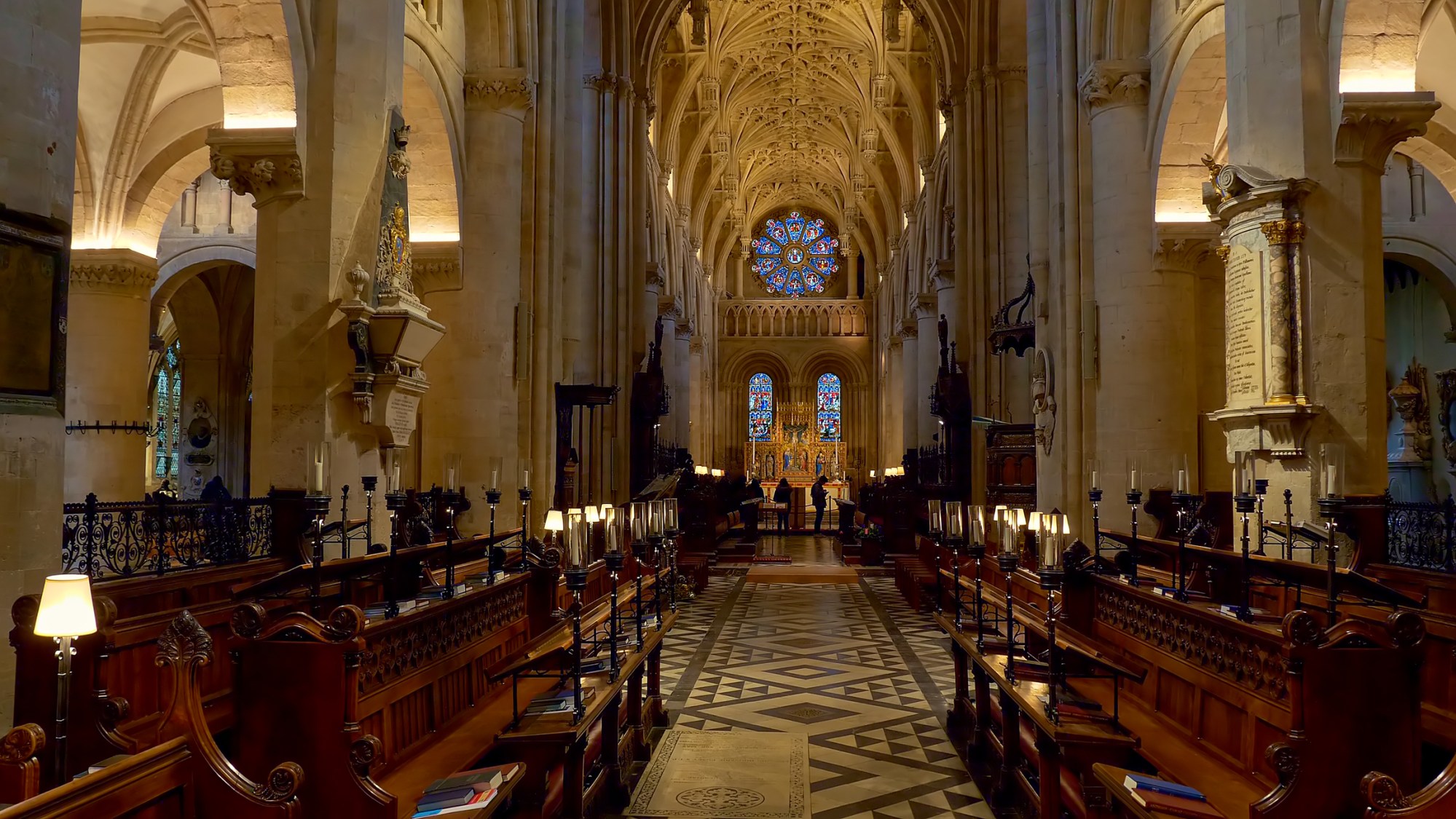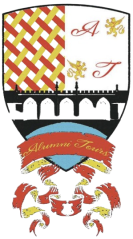Religious Buildings

Religious Buildings
Just as Oxford cannot really be understood without understanding the university, so too can Oxford not really be understood without considering its religious history. As well as being embedded in Oxford’s cultural practices, the city is steeped in religious buildings. The most notable of which are here below!
Christchurch College Chapel
Christchurch College chapel is unique in that it is both a college chapel and the official cathedral of the University of Oxford. Once the Priory Church of St Frideswide, it was extended to form part of Cardinal College when it was established by Thomas Wolsey in 1526. Cardinal College was never completed due to Wolsey’s death but was refounded as Christchurch College in 1548 by King Henry VIII.
Today, the Chapel is the cathedral of the Diocese of Oxford. It is administered by the Dean: The Very Revd Martyn Percy, who also has the honour of being the only living theologian mentioned in Dan Brown’s The Da Vinci Code.
University Church of St. Mary the Virgin
Despite Christchurch chapel being the official cathedral of Oxford, the most important church in the city the Church of St. Mary the Virgin. The church was the headquarters of the University of Oxford until the construction of the Divinity School and Bodleian Library. The church spire is the oldest preserved structure in Oxford, dating to 1270.
In 1555, the church was the site of the trial of the Oxford Martyrs in which the bishops Latimer, Ridley, and Cranmer were tried for heresy. They were found guilty and ultimately burned at the stake in the north for the city, on what is now St. Giles.
Graduation ceremonies took place in the church until the 17th century. These were a very rowdy affair, which William Laud, the Archbishop of Canterbury, critised saying that at the ceremony, “sacrifice is made equally to God and Apollo’, in the same place where homage was due to God and God alone”.
St Michael at the Northgate
St Michael at the Northgate is at the northern end of Cornmarket Street. Since 1971, it has served as the City Church of Oxford, meaning this is where the mayor and city corporation are expected to worship. Built between 1000 and 1050, the church is Oxford’s oldest building. The Anglo-Saxon tower still looms over Cornmarket Street and each year on Ascension Day, the vicar leads the ceremony of “beating the bounds”. During this time, parishioners beat the boundary stones of the church with willow wands while chanting, “mark, mark, mark!”. The origins of the tradition are hazy, but they are thought to derive from the Roman festival Terminalia, which celebrated landmarks.
St Mary Magdalen Church
Anyone strolling down Magdalen Street (perhaps visiting the “Big Tesco”) will surely notice St. Mary Magdalen’s Church, which feels like the symbolic start of Oxford’s Old Town. The original Saxon church was burned down in 1074 and was replaced by a single-aisle chapel which was rebuilt to a larger size in 1194. Of this structure, the east wall of the chancel wall survives. In 1841, the church was restored by George Gilbert Scott (not to be confused with his son, Gilbert Gilles Scott, who designed the Weston Library and Britain’s iconic red telephone boxes). The building is Grade-1 listed and the bells have been rung by the Oxford University Society of Change Ringers since the 1930s.
The Friary Oxford
Oxford is home to its own order of Franciscan monks, dating back to the 13th century. The original Greyfriars established themselves in Oxford in 1224, but the order was suppressed during the 16th century. Located on St. Mary’s Road, Cowley, monks will spend a year as a novice in the United States before studying at Blackfriars Hall whilst living at the friary’s “formation house”. They settled in their current location in 2014, when the formation house moved into the former convent of All Saints Sisters of the Poor.
Christianity is by far the most common of Oxford’s religions. Indeed, the history of the city is deeply intertwined with Christian education; many colleges are modelled on monasteries containing a chapel, library, and dormitories. Today, however, Oxford is a diverse and international city and boasts religious temples of many religions.
Islam in Oxford
The Oxford Central Mosque is located on Manzil Way and offers classes on Arabic, the Quaran, and Islam. There is also a mosque located in the Oxford Centre for Islamic Studies. Located on Marston Road, overlooking the river Cherwell and various college sports grounds, the Oxford Centre for Islamic Studies is a beautiful building, designed Abdel-Wahed El-Wakil, considered by many to be the world’s foremost expert on Islamic architecture.
Oxford Jewish Congregation
Located in Jericho, the Oxford Jewish Congregation offers a rare sense of community were orthodox and non-orthodox Jews worship together. In addition to religious services, the synagogue offers kosher meals during term time, and hosts various social events including a café on Sunday mornings.
Buddhism in Oxford
Oxford has two main centres of Buddhism, the Triratna Centre on Barracks Lane and the the Oxford Buddha Vihara on Abingdon Road. Triaratna Buddhism is a modernist Buddhist movement which uses Buddhist teachings to explore mindfulness in ways which are useful to contemporary life. The centre offers regular meditation classes. The Oxford Buddha Vihara is a more traditional temple, based in South East Asian traditions of Buddhism and offers meditation retreats.
Hinduism in Oxford
Despite Oxford being home to some 10,000 Hindus, there is no permanent Hindu temple in Oxford. Instead, the Oxford Hindu Temple and Community Centre hosts a variety of regular events which celebrate Hindu culture and festival celebrations in different spaces around the city.
Colleges
In addition to the plethora of churches, many University of Oxford colleges take their names from saints. In brief, here are their stories:
- Anne’s College – Named for St Anne, mother of Mary and grandmother of Jesus.
- Anthony’s College – Named for St. Anthony of Egypt, an early Christian monk who had many supernatural encounters in the East Egyptian Desert.
- Catherine’s College – Named for Catherine of Alexandria (who was based on Hypatia of Alexandria), a martyr who converted hundreds to Christianity.
- Cross College – Not named for a St. but because it’s on St. Cross road!
- Edmund Hall – Named for Edmund of Abingdon, a 13th century monk who served as the Arch Bishop of Canterbury, promoted the study of Aristotle, preached the sixth crusade, defended the Magna Carta and negotiated a peace with Llywelyn the Great.
- Hilda’s College – Named for Hilda of Whitby, the founding abbess of Whitby, an important figure in the Christianisation of England.
- Hugh’s College – Named for Hugh of Lincoln, the patron saint of sick children, sick people, shoemakers, and swans.
- John’s College – Named for John the Baptist, who baptised Jesus in the Jordan River.
- Peter’s College – Named for St. Peter, disciple of Christ.
-Adam Johnson, St. Catherine’s College alumnus
